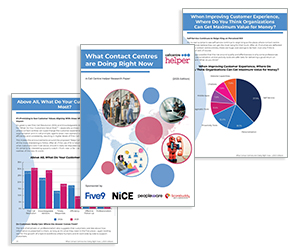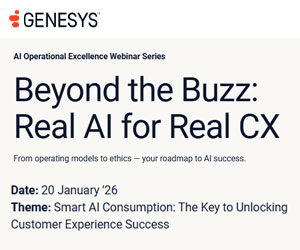This blog summarizes the key points from a recent article from David McGeough at Scorebuddy, where he explores how blending AI with human agents in your contact centre could work, and how this balance is set to define the future of customer service.
Customer service has never been more critical, 88% of consumers say it directly impacts brand loyalty. At the same time, expectations are rising, and contact centres face more pressure than ever to deliver seamless, efficient support.
As AI-driven tools and automation reshape the landscape of customer service, many wonder: will AI replace human support agents? The answer is a clear no.
AI isn’t here to take over, it’s here to enhance. When used strategically, AI bridges the gap between rising customer expectations and operational efficiency.
But it’s the combination of AI’s speed and a human agent’s empathy and insight that creates truly exceptional customer experiences.
Will AI Replace Customer Support Teams? Not Quite
AI is transforming the landscape of contact centres with remarkable speed. As of this year, 98% of call centres are using AI in some form – primarily for tasks like:
- Running chatbots
- Powering virtual assistants
- Analysing interaction data
These innovations excel at managing repetitive tasks and cutting down on overhead. Chatbots provide instant responses to FAQs, assist with self-service transactions, and offer round-the-clock support.
Virtual agents reduce queue times and speed up resolutions, all while giving human staff more bandwidth to tackle higher-value work.
That said, the idea that AI will entirely replace live agents isn’t realistic – and arguably, it never should. Even though AI tools can now handle 50-60% of inquiries, the rest still depend on human input and discretion.
Why? Because AI – no matter how advanced – still struggles with nuance, emotional sensitivity, and contextual understanding.
Why AI Isn’t Ready to Lead the Frontlines Alone
Today’s customers expect empathy, flexibility, and understanding. But AI lacks the emotional intelligence needed to navigate delicate conversations or resolve situations that fall outside a narrow set of rules.
Complex problem-solving remains firmly in the hands of humans. Agents can interpret tone, adapt to unexpected challenges, and think creatively – all capabilities that AI simply cannot match at scale.
AI also relies heavily on historical data. If the training data is flawed or biased, the system can make inaccurate predictions or spread misinformation – an outcome that could harm customer trust.
Cultural perception also matters: while over 70% of customers in India and China trust AI, only 32% of U.S. consumers say the same (Axios).
Rather than replacing people, AI should be viewed as a performance multiplier. With the right tools, agents can:
- Offload low-value work
- Receive actionable coaching in real time
- Tap into trends that enhance service delivery
7 Examples of What AI-Enhanced Support Actually Looks Like
We’ve come a long way from clunky scripts and static spreadsheets. The modern customer experience runs on natural language processing (NLP), machine learning, and real-time intelligence.
But the key is this: AI performs best when it supports human agents, not when it tries to replace them. Here’s how that looks in action:
1. Managing Routine Tasks With AI Assistants
AI chatbots handle high volumes of everyday queries across multiple platforms – from live chat to email to SMS. Common uses include:
- Tracking orders
- Resetting passwords
- Booking or modifying appointments
- Updating account information
This dramatically lowers call traffic and allows skilled agents to focus on complex or emotional customer needs.
2. Delivering Live Support to Agents on the Floor
AI can analyse conversations as they unfold, flagging tone, intent, and keywords to suggest helpful prompts, responses, or next actions.
This live guidance helps maintain consistency, boost compliance, and improve outcomes – all while enhancing the agent experience.
3. Surfacing Critical QA Insights
Instead of reviewing 2-3% of calls manually, AI can review 100% of interactions. It flags:
- Compliance risks
- Poor sentiment
- Performance improvement opportunities
With this insight, QA managers can deliver focused, timely coaching that actually moves the needle.
4. Hyper-Personalizing Customer Service
AI can sift through CRM records, past interactions, and behavioural data to tailor responses, surface offers, and pre-empt escalation.
This enables agents to offer more meaningful conversations and build loyalty through personalized engagement.
5. Levelling Up Training and Coaching
With performance analytics on each agent, AI enables customized learning paths. Managers can coach based on real, observable behaviour instead of guesswork or gut feel.
This helps close skill gaps, reinforce strengths, and raise overall service quality.
6. Monitoring Sentiment and Escalation Triggers
AI tools can detect emotional tone and flag when a conversation starts to go south.
In such cases, a supervisor alert or automatic escalation ensures human intervention arrives early, before frustration turns into churn.
7. Partnering With People-Not Replacing Them
AI provides insights and automation, but it’s humans who bring empathy, understanding, and creativity.
The future lies in blending automation with human empathy – not choosing one over the other.
A 4-Pillar Framework for AI-Powered Assurance
Traditional QA can’t keep up. Evaluating just a few percent of calls is not enough in a world where expectations are rising and customer loyalty is fragile.
Here’s how AI transforms quality monitoring by following a four-pillar model:
Pillar 1: Automating Quality Monitoring
AI allows full-scale monitoring across voice, chat, email, and social platforms. It can auto-score conversations using consistent metrics, such as:
- Tone and sentiment
- Keyword triggers
- Resolution success
This frees up QA teams to focus on deeper analysis and strategic coaching rather than time-consuming scoring tasks.
Pillar 2: Extracting Hidden Insights
AI uncovers trends across all interactions-trends that would be invisible in a manual 3% sample. It can spotlight:
- Frequent product issues
- Common call drivers
- Emerging customer pain points
This intelligence is invaluable for product, CX, and operations teams aiming to eliminate root causes of dissatisfaction.
Pillar 3: Enhancing QA Capabilities
AI dashboards provide real-time visibility into performance metrics like sentiment, AHT, and first-call resolution. This allows managers to:
- Pinpoint coaching opportunities
- Detect underperforming trends
- Benchmark across teams and locations
Pillar 4: Recommending Targeted Actions
AI goes beyond diagnosing issues – it offers solutions. From custom coaching plans to suggested knowledge base updates, the system helps:
- Close knowledge gaps
- Streamline workflows
- Drive measurable performance improvements
How to Prepare Your Team for AI-Driven Workflows
AI isn’t just a software upgrade – it’s a fundamental shift in how contact centres operate. It changes agent responsibilities, manager expectations, and performance metrics.
Without proactive planning, these changes can lead to confusion or resistance. Here’s how to set your team up for success:
Clarify the Purpose Behind the Tools
Only 40% of workers globally say they have access to AI at work, and many don’t understand its benefits. Be clear about:
- How AI improves work, not replaces it
- What problems it solves
- Why adoption matters
Early, honest communication builds trust and helps employees embrace the changes.
Train Continuously, Not Just Once
AI tools are powerful – but only if your team knows how to use them. Provide hands-on training to:
- Show how AI makes decisions
- Build comfort with AI dashboards
- Explain performance scoring and feedback
And keep the learning going. A one-time onboarding session isn’t enough. Ongoing support is essential for lasting success.
Prioritize Human Skills
AI can analyse and recommend – but people connect. Reinforce soft skills like empathy, judgment, and communication.
Encourage coaching that blends data-driven insights with emotional intelligence so your team becomes not just faster, but better.
“If team leaders just forward AI reports to agents without interpretation, it won’t land. Coaching matters more than ever.” – Martin Teasdale
Redesigning the Customer Journey for Human + AI Synergy
The best customer journeys use AI to streamline processes while making it easy for customers to reach real humans when needed.
Start by refining call routing. AI can assess intent and steer customers toward the most efficient resolution – whether that’s a chatbot, FAQ tool, or live rep. But make sure the handoff to humans is seamless.
AI should also support reps in real-time and flag when to escalate. Customers should always have the option to speak to a person.
And don’t forget post-interaction analysis. AI-powered QA tools can pinpoint drop-off points or inefficiencies in the journey and guide improvements.
Human Connection + AI Speed = The Future of Support
AI is here to stay – and in the contact centre space, it’s already delivering game-changing efficiency and insight. But the human element is still the core of great service.
The contact centres that win in the future won’t be the ones that replace agents with bots – they’ll be the ones that equip agents with better tools.
This blog post has been re-published by kind permission of Scorebuddy – View the Original Article
For more information about Scorebuddy - visit the Scorebuddy Website
Call Centre Helper is not responsible for the content of these guest blog posts. The opinions expressed in this article are those of the author, and do not necessarily reflect those of Call Centre Helper.
Author: Scorebuddy
Reviewed by: Jo Robinson
Published On: 15th Jul 2025
Read more about - Guest Blogs, David McGeough, Scorebuddy






 Scorebuddy is quality assurance solution for scoring customer service calls, emails and web chat. It is a dedicated, stand-alone staff scoring system based in the cloud, requiring no integration.
Scorebuddy is quality assurance solution for scoring customer service calls, emails and web chat. It is a dedicated, stand-alone staff scoring system based in the cloud, requiring no integration. 































